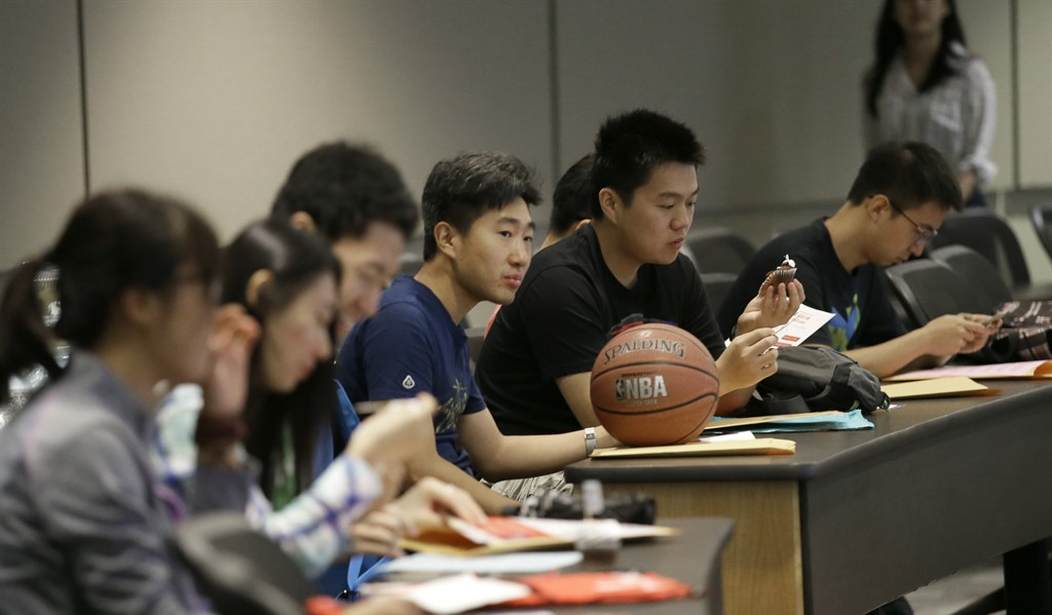High school seniors are eagerly watching their mail this month, hoping for the "fat envelope" indicating acceptance by the college of their choice. Unfortunately, more American students are receiving the "thin envelope" because college acceptance rates are continuing their decade-long decline.
The most selective public colleges, such as UCLA and Michigan, now take one out of six applicants, compared to one out of three a decade ago. Top private colleges, such as Stanford and Harvard, admit one out of 20 applicants, compared to one out of 10 a decade ago.
What explains the steady decline in college admission rates for America's best high-school students? Is it really true that the percentage of high-school graduates who are prepared for college keeps getting smaller?
One reason for this trend is the huge increase of students from foreign countries, especially China, who are admitted to study on American campuses. The numbers of Chinese and other foreign students who go to college in the U.S. is truly mind-boggling.
The University of Illinois has 5,000 Chinese students on its Champaign-Urbana campus, compared with less than 100 a decade ago. Students from the People's Republic of China made up a tenth of last year's freshman class.
California has more U.S.-born Chinese students than any other state, but its public colleges nevertheless admit huge numbers of students from mainland China, including 1,200 at UC Berkeley (up from 47 a decade ago) and 2,200 at UC San Diego (up from 70). Of the nearly 1 million people living in the United States on F-1 student visas, about 360,000 are from China.
Recommended
Why did U.S. universities decide to open their doors to foreign students? Follow the money. Foreign students usually pay full tuition rates, which could be two or three times more than American students pay.
Like any business seeking to exploit a new profit opportunity, the higher education "industry" has hired more Chinese-speaking staff in order to recruit more students and cater to them after they arrive on campus. Some U.S. universities even hold pre-departure orientations in China.
The lure of higher tuition has tempted state colleges to lower their admission standards for foreign and other out-of-state students. The California State Auditor recently found that the average SAT scores and grades of out-of-state students were lower than those of in-state students, and that state universities had rejected 4,500 Californians whose test scores and grades were good enough for out-of-state and foreign students.
Chinese students do seem to have plenty of money to spend, and not just for tuition, room and board. Many drive expensive cars and wear fashionable clothing, which makes them stand out among typical American college students.
While an American kid might drive a beat-up Toyota handed down from an older member of the family, Chinese students seem to have no problem affording a new Audi, BMW or Lexus. In the Boston area, which has 44,000 foreign students attending dozens of colleges, the 12,000 Chinese students are often seen driving Maseratis, Lamborghinis, and Range Rovers.
At Michigan State in East Lansing, where 4,400 Chinese students are enrolled, Chinese students accounted for 10 to 20 percent of a luxury car dealer's entire sales. Chinese students provided 8 percent of the sales of a luxury car dealership near the University of Oregon at Eugene, and 5 percent of sales by a luxury dealer near the University of Iowa in Iowa City.
In case you're thinking that Chinese students must be some of "the best and the brightest" who provide the brainpower needed by America's engineering schools, nothing could be further from the truth. Most Chinese students have no better than average ability, and many do not speak, write, or understand English well enough to contribute significantly to the academic community.
A professor of Chinese history at New York University told the Wall Street Journal that students from China often pose a "burden" on her lectures, which she has to modify for their benefit. Many Chinese students "are woefully underprepared," she said.
WholeRen Education, a U.S. company that caters to students from China, reported that some 8,000 Chinese students were expelled from American universities last year, mostly for poor academic performance or cheating. "Chinese students used to be considered top-notch," a WholeRen executive said, "but over the past five years their image has changed completely -- wealthy kids who cheat."
The Reuters news service has just published an in-depth examination of Chinese cheating on college entrance exams such as the SAT, which is administered in China under license from the College Board. In many cases, actual test questions and even entire test booklets were found on Chinese web sites or used by Chinese cram schools.
Some Chinese families aren't waiting to send their kids off to college in the U.S., but are starting much earlier. About 35,000 K-12 students from China, some as young as 10 years old, now live in the U.S., many paying non-resident tuition to attend U.S. public schools.
























Join the conversation as a VIP Member